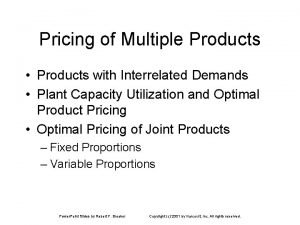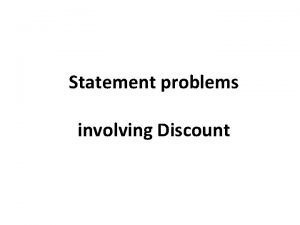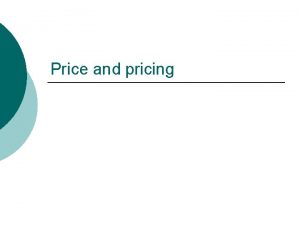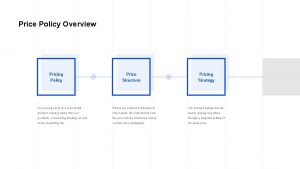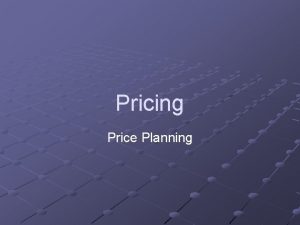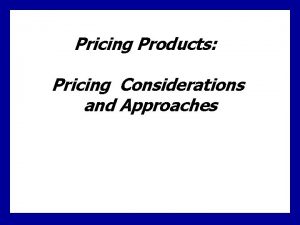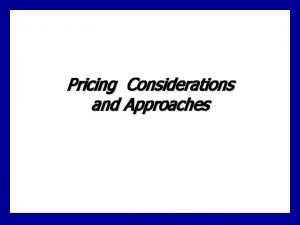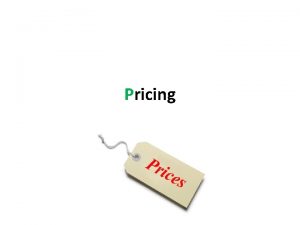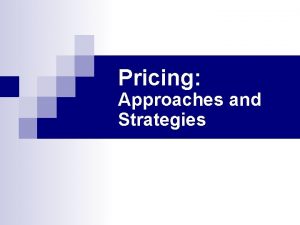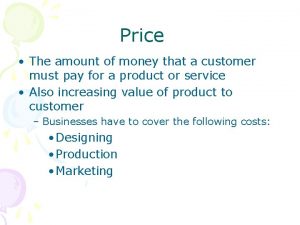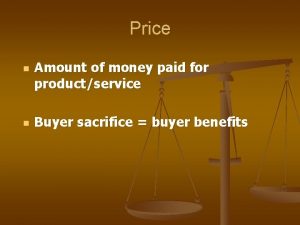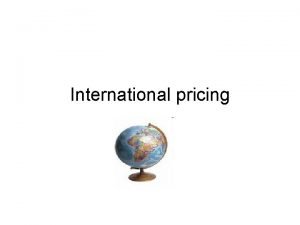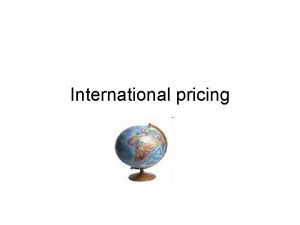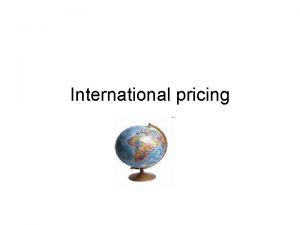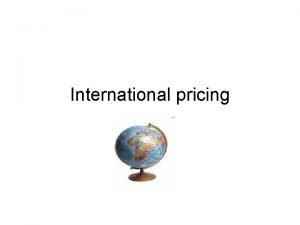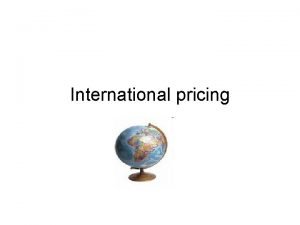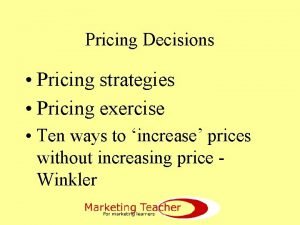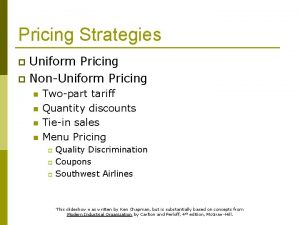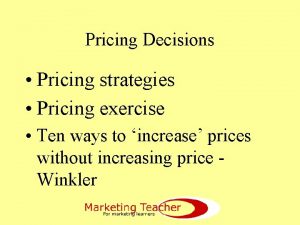PRICING PRODUCTS Price the amount of money charged











































- Slides: 43

PRICING PRODUCTS

Price - the amount of money charged for a product or service, or the sum of the values that consumers exchange for the benefits of having or using the product or service.

Factors to consider when setting prices 1. Internal factors a. marketing objectives( survival, current profit maximization, market share leadership, product quality leadership)

b. Marketing mix strategy c. Target costing - pricing that starts with an ideal selling price, then targets costs that will ensure that the price is met.

Types of costs fixed costs- do not vary with production or sales level variable costs- vary directly with the level of production total costs-sum of the fixed and variable costs.

Experience curve or learning curve - the drop in the average per unit production cost that comes with accumulated production experience.

C. Organizational considerations

2. External Factors Affecting Pricing Decisions

2. External Factors a. The market and demand - pricing in different types of market (pure competition, monopolistic competition, oligopolistic competition, pure monopoly) - law of demand supply

Price elasticity - A measure of the sensitivity of demand to changes in price.

B. Competitors’ costs and prices c. other external factors - economic conditions - the government

General Pricing Approaches

I. Cost-Based Pricing 1. Cost-plus pricing - adding a standard markup to the cost of the product

2. Break-even pricing(target profit pricing) - setting price to bvreakeven on the costs of making and marketing a product; or setting price to make a target profit breakeven volume = fixed cost/(price-variable cost per unit)

II. Value-Based pricing - setting price based on buyers’ perceptions of value rather than on the seller’s cost. Value pricing - offering just the right combination of quality and good service at a fair price

III. Competition-Based Pricing - setting prices based on the prices that competition chage for similar products.

New-Product Pricing Strategies

1. Market-skimming pricing - Setting a high price for a new product to skim maximum revenues layer by layer from the segments willing to pay the high price; the company makes fewer but more profitable sales.

2. Market penetration pricing - setting a low price for a new product in order to attract a large number of buyers and a large market share.

Product Mix Pricing Strategies

1. Product line pricing - setting the price steps between various products in a product line based on cost differences between the products, customer evaluations of different features, and competitors’ prices

2. Optional-product pricing - the pricing of optional or accessory products along with a main product.

3. Captive-product pricing - setting a price for products that must be used along with a main product.

4. By-product pricing - setting a price for by-products in order to make the main product’s price more competitive.

5. Product bundle pricing - combining several products and offering the bundle at a reduced price.

Price-Adjustment Strategies

1. Discount and Allowance pricing a. cash discount - a price reduction to buyers who pay their bills promptly.

b. quantity discount - a price reduction to buyers who buy large volumes.

c. Functional discount - a price reduction offered by the seller to trade channel member who perform certain functions such as selling, storing, and record keeping.

d. seasonal discount - a price reduction to buyers who purchase merchandise or services out of season.

e. allowance - promotional money paid by manufacturers to retailers in return for an agreement to feature the manufacturer’s products in some way. Trade allowance- price reductions given for turning in an old item when buying a new one.

Promotional allowancespayments or price reductions to reward dealers for participating in advertising and sales support programs.

2. Segmented Pricing - selling a product or service at two or more prices, where the difference in prices is not based on differences in costs.

3. Psychological pricing considers the psychology of prices and not simply the economics; the price is used to say something about the product

reference prices - prices that buyers carry in their minds and refer to when they look at a given product

4. Promotional pricing temporarily pricing products below the list price, and sometimes even below cost, to increase short-run sales.

5. Geographical pricing a. FOB-origin pricing goods are placed free on board a carrier; the customer pays the freight from the factory to the destination.

b. uniform-delivered pricing the company charges the same price plus freight to all customers, regardless of their location.

c. Zone pricing - the company sets up two or more zones. All customers within a zone pay the same total price; the more distant the zone, the higher the price.

d. basing-point pricing - the seller designates some city as a basing point and charges all customers the freight cost from that city to the customer location, regardless of the city from which the goods are actually shipped.

e. Freight-absorption pricing the seller absorbs all or part of the actual freight charges in order to get the desired business.

Public Policy and Pricing price fixing - states that sellers must set prices without talking to competitors.

predatory pricing - selling below cost with the intention of punishing a competitor or gaining higher long run profits by putting competitors out of business.
 Money money money team
Money money money team Kilala rin bilang price support at minimum price policy
Kilala rin bilang price support at minimum price policy Multiple product pricing
Multiple product pricing Marketing mix of pepsi and coca cola
Marketing mix of pepsi and coca cola Functional and innovative products supply chain
Functional and innovative products supply chain Great gatsby meaning
Great gatsby meaning Symbolism in great gatsby
Symbolism in great gatsby Tom buchanan character traits
Tom buchanan character traits Money smart money match
Money smart money match Money on money multiple
Money on money multiple Asfa products price list
Asfa products price list Marked price-selling price=
Marked price-selling price= Installment payment system
Installment payment system 7 step strategic sourcing process
7 step strategic sourcing process Price discovery and price determination
Price discovery and price determination Lời thề hippocrates
Lời thề hippocrates Vẽ hình chiếu đứng bằng cạnh của vật thể
Vẽ hình chiếu đứng bằng cạnh của vật thể Quá trình desamine hóa có thể tạo ra
Quá trình desamine hóa có thể tạo ra Phản ứng thế ankan
Phản ứng thế ankan Các môn thể thao bắt đầu bằng tiếng bóng
Các môn thể thao bắt đầu bằng tiếng bóng Sự nuôi và dạy con của hươu
Sự nuôi và dạy con của hươu Hình ảnh bộ gõ cơ thể búng tay
Hình ảnh bộ gõ cơ thể búng tay Các loại đột biến cấu trúc nhiễm sắc thể
Các loại đột biến cấu trúc nhiễm sắc thể điện thế nghỉ
điện thế nghỉ Nguyên nhân của sự mỏi cơ sinh 8
Nguyên nhân của sự mỏi cơ sinh 8 Trời xanh đây là của chúng ta thể thơ
Trời xanh đây là của chúng ta thể thơ Chó sói
Chó sói Thiếu nhi thế giới liên hoan
Thiếu nhi thế giới liên hoan Tia chieu sa te
Tia chieu sa te Một số thể thơ truyền thống
Một số thể thơ truyền thống Thế nào là hệ số cao nhất
Thế nào là hệ số cao nhất Hệ hô hấp
Hệ hô hấp Frameset trong html5
Frameset trong html5 Số nguyên tố là
Số nguyên tố là Tư thế ngồi viết
Tư thế ngồi viết đặc điểm cơ thể của người tối cổ
đặc điểm cơ thể của người tối cổ Mật thư tọa độ 5x5
Mật thư tọa độ 5x5 Các châu lục và đại dương trên thế giới
Các châu lục và đại dương trên thế giới Tư thế worms-breton
Tư thế worms-breton ưu thế lai là gì
ưu thế lai là gì Thẻ vin
Thẻ vin Cái miệng nó xinh thế
Cái miệng nó xinh thế Các châu lục và đại dương trên thế giới
Các châu lục và đại dương trên thế giới Bổ thể
Bổ thể


